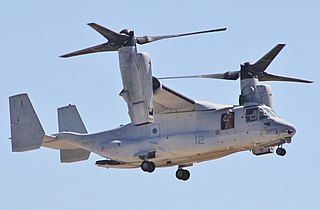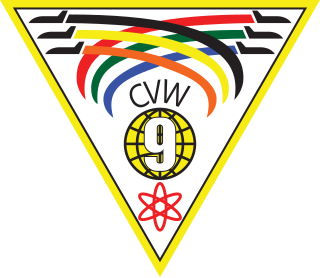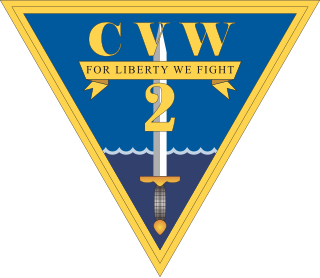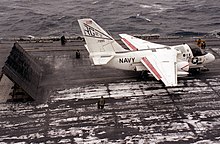
The Lockheed S-3 Viking is a four-crew, twin-engine turbofan-powered jet aircraft designed and produced by the American aerospace manufacturer Lockheed Corporation. Because of its characteristic sound, it was nicknamed the "War Hoover" after the vacuum cleaner brand.

The Bell Boeing V-22 Osprey is an American multi-mission, tiltrotor military aircraft with both vertical takeoff and landing (VTOL) and short takeoff and landing (STOL) capabilities. It is designed to combine the functionality of a conventional helicopter with the long-range, high-speed cruise performance of a turboprop aircraft.

USS George H.W. Bush (CVN-77) is the tenth and final Nimitz-class supercarrier of the United States Navy. She is named for the 41st President of the United States and former Director of Central Intelligence George H. W. Bush, who was a naval aviator during World War II. The vessel's callsign is Avenger, after the TBM Avenger aircraft flown by then-Lieutenant George H. W. Bush in World War II. Construction began in 2003 at Northrop Grumman, in Newport News, Virginia and was completed in 2009 at a cost of $6.2 billion. Her home port is Naval Station Norfolk, Virginia.

USS Nimitz (CVN-68) is an aircraft carrier of the United States Navy, and the lead ship of her class. One of the largest warships in the world, she was laid down, launched, and commissioned as CVAN-68, "aircraft carrier, attack, nuclear powered", but she was later redesignated as CVN-68, "aircraft carrier, multi-mission, nuclear-powered", on 30 June 1975, as part of a fleet-wide realignment that year.

The Grumman C-2 Greyhound is a twin-engine, high-wing cargo aircraft designed to carry supplies, mail, and passengers to and from aircraft carriers of the United States Navy. Its primary mission is carrier onboard delivery (COD). The aircraft provides critical logistics support to carrier strike groups. The aircraft is mainly used to transport high-priority cargo such as jet engines and special stores, mail, and passengers between carriers and shore bases.

The Grumman TBF Avenger is an American World War II-era torpedo bomber developed initially for the United States Navy and Marine Corps, and eventually used by several air and naval aviation services around the world.

The Grumman C-1 Trader is a carrier onboard delivery (COD) variant of the Grumman S-2 Tracker. It was replaced by a similar version of the Northrop Grumman E-2 Hawkeye, the Grumman C-2 Greyhound.

A folding wing is a wing configuration design feature of aircraft to save space and is typical of carrier-based aircraft that operate from the limited deck space of aircraft carriers. The folding allows the aircraft to occupy less space in a confined hangar because the folded wing normally rises over the fuselage decreasing the floor area of the aircraft. Vertical clearance is also limited in aircraft carrier hangar decks. In order to accommodate for this, some aircraft such as the Supermarine Seafire and Fairey Gannet have additional hinges to fold the wingtips downward, while others such as the S-3 Viking have folding tails. The F-14 Tomcat's variable-sweep wings could be "overswept" to occupy less space.

A naval aviator is a commissioned officer or warrant officer qualified as a crewed aircraft pilot in the United States Navy or United States Marine Corps. United States Coast Guard crewed aircraft pilots are officially designated as "Coast Guard aviators", although they complete the same undergraduate flight training as Navy and Marine Corps crewed aircraft pilots, and are awarded the same aviation breast insignia.

A carrier air wing is an operational naval aviation organization composed of several aircraft squadrons and detachments of various types of fixed-wing and rotary-wing aircraft. Organized, equipped and trained to conduct modern US Navy carrier air operations while embarked aboard aircraft carriers, the various squadrons in an air wing have different but complementary missions, and provide most of the striking power and electronic warfare capabilities of a carrier battle group (CVBG). While the CVBG term is still used by other nations, the CVBG in US parlance is now known as a carrier strike group (CSG).

Carrier Air Wing Nine (CVW-9) is a United States Navy aircraft carrier air wing based at Naval Air Station Lemoore. The Air Wing is currently assigned to the aircraft carrier USS Abraham Lincoln (CVN-72). The Tail Code of aircraft assigned to CVW-9 is NG.

Carrier Air Wing Two (CVW-2) is a United States Navy aircraft carrier air wing based at Naval Air Station Lemoore. The air wing is attached to the aircraft carrier USS Carl Vinson (CVN-70).

Fleet Logistics Support Squadron 30 (VRC-30) is an aviation unit of the United States Navy tasked with carrier onboard delivery. The squadron is nicknamed "Providers" and is based at Naval Air Station North Island, California (USA). In contrast to most other U.S. Navy squadrons, VRC-30 consists of five seaparately named detachments, which are assigned to different carrier air wings.

Fleet Logistics Support Squadron 40 (VRC-40), also known as the "Rawhides", is a United States Navy fleet logistics support squadron based at NS Norfolk. Commissioned in 1960, it is one of only two active fleet logistics squadrons in the Navy, the other being VRC-30.

A carrier-based aircraft is a naval aircraft designed for operations from aircraft carriers. Carrier-based aircraft must be able to launch in a short distance and be sturdy enough to withstand the abrupt forces of launching from and recovering on a pitching deck. In addition, their wings are generally able to fold up, easing operations in tight quarters.

Airborne Command & Control Squadron 120 (VAW-120) is a United States Navy Fleet Replacement Squadron responsible for training crews on the E-2 Hawkeye and the C-2A(R) Greyhound.

Fleet Logistics Support Squadron 62 (VR-62), nicknamed the Nomads, is one of five U.S. Navy Reserve squadrons operating the Lockheed C-130T Hercules medium-lift cargo aircraft. Based at Naval Air Station Jacksonville, Florida, the squadron is manned by a combination of traditional part-time drilling Selected Reservists (SELRES) and a full-time active duty Navy Reserve cadre known as Training and Administration of the Reserve (TAR) personnel (previously known as Full Time Support (FTS) personnel from August 2006 to November 2021). The squadron is under the operational control of Commander, Fleet Logistics Support Wing(COMFLELOGSUPWING) at NAS JRB Fort Worth, Texas.

Fleet Logistics Multi-Mission Squadron 30 (VRM-30) is an aviation unit of the United States Navy.























